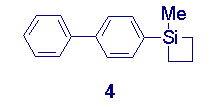
Jennifer Schmeisser - University of Waterloo
Placement: McMaster University
Supervisor: Dr. Willie Leigh
Current Position: Graduate student, Department of Chemistry, Simon
Fraser University
The Photochemistry of Arylmethylsilacyclobutanes
Arylsilacyclobutanes such as 1 have been shown in the past to be reasonable precursors to transient intermediate silenes (e.g. 2) when irradiated in the mid-UV range. Silenes are usually very reactive (for example, 2 has a lifetime of less than a few microseconds at room temperature), and can be trapped as the corresponding alkoxysilane (3) upon irradiation of the silacyclobutane in the presence of methanol.

Phenylmethylsilacyclobutane (1) has been shown to produce silene 2 with a low quantum yield, » 0.03. The objective of my project was to synthesize and study biphenylmethylsilacyclobutane (4), to determine what differences in photochemistry would result from extending the aryl substituent. It was expected that by adding the second aromatic group, and thereby lowering the singlet state energy, that the quantum yield of silene formation would be even lower than that of 1.

Fluorescence, laser flash photolysis, and steady state photolysis were used to define the photochemistry and photophysics of 4. The results that we found were opposite to this prediction, and the quantum yield actually increased almost 10-fold by the addition of a second phenyl ring.
This unexpected result suggests that the aromaticity of the substituent may play a more important role in the cleavage of the Si-C bond and needs further study. Also, the door is now open to investigate other substituents that lower the singlet state energy even more, possibly into the visible range.
| Back to: | 1998 RISE Scholars RISE Home Page. |
21-sep-98